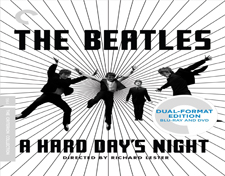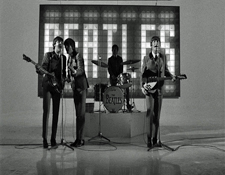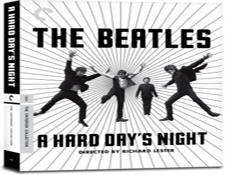It’s the time of year for saving money!
Honestly, I have been struggling to come up with a compelling angle for my review of the new Criterion restoration of The Beatles’ 1964 film A Hard Day’s Night. Yes, the Blu-ray looks and sounds pretty spectacular, with lovely fresh 5.1 surround, stereo and monaural sound tracks to complement the pristine, crystal clear images made off of original 35 MM negative sources and created with the input of original director Richard Lester.
 But after that, really, what else is there to say that hasn’t already been said a bazillion times over elsewhere?
But after that, really, what else is there to say that hasn’t already been said a bazillion times over elsewhere?
What’s that you say? It comes in a fabulous tri-fold package with a well laid out and informative 80-page booklet! Yeah, that is true, but that is not what the readers of Audiophilereview.com probably tend to care about when reading reviews here.
But then the other night something magical happened: I went to see A Hard Day’s Night again in a real movie theater and that gave me some inspiration as to what I needed to write about for you, Dear Readers, something that might actually add some value to your day.
You see, I saw A Hard Day’s Night in one of the great movie houses remaining in America, The Castro here in San Francisco. It is one of those grand viewing halls that has been maintained and restored over the years — it even still has a live organist who rises out of the orchestra pit before films and plays a medley of music. This time he played Beatle tunes!
I was very curious to see this film on that big screen not only because I knew it would be fun seeing it with friends and a roomful of other Beatle people, but I also wanted to see how the new 4K transfer looked on the big screen. If you aren’t familiar with the changes a-brew’n in ultra high definition video for cinema (and perhaps eventually the home), take a quick look at this wiki page which I’m assuming is somewhat accurate and is at minimum a good place to start ).
That said, I have to take a flashback detour to about a year ago to and my experience regarding the reissue of another Beatles related film, Yellow Submarine and it’s accompanying Blu-ray reissue. In that instance the Blu-ray looked and sounded quite wonderful but the film as shown in this very same theater looked just so so. It was disappointing. So disappointing that — especially now that I have seen a very definite 4K film in A Hard Days Night — I am wondering if the Yellow Submarine that was just a standard older version. You see, the Blu-ray disc — as seen in my apartment-appropriate home theater type viewing distance — looked much much better than what I saw in the movie theater (and another Beatle friend concurred with me on this opinion). So I am wondering (and suspecting even) if perhaps at that time the theater wasn’t equipped to handle 4K so maybe they just played an older version. Or maybe they didn’t have access to a new print.
I may never know for sure… but…. regardless … I was thusly extra interested to see if there would be a noticeable difference between the new Blu-ray and this spiffy 4K transfer of A Hard Days Night.
I am happy to report that all the industry buzz about 4K seems to be true because this print I saw at the Castro Theater looked as good on the huge screen before an audience of hundreds of people as it does on the smaller scale, 50-inch Plasma TV in my modest apartment sized home theater set up. That is a big distinction to take into consideration. It is one thing to show fine detail on a high resolution digital screen viewed at close proximity. But to be able to deliver that sort of detail on a projection basis in a theater that holds upwards of 500 people, that is an accomplishment.
My Beatle-buddy Frank and I were both geeking out big time during the film noticing all sorts of little details neither of us had noticed before. I had the advantage over Frank in that I have watched my Blu-ray of A Hard Days Night a couple times already before this theater viewing, so I was able to point out details to him such as the fingerprints and scratches on the guitars and still more fingerprints on the window to the control room in the broadcast studio scenes. We noticed fine details such as the individual hairs on the director’s V-neck sweater as well as on his head. You can see the stubble on John and Paul’s close ups as sweat beads on their brows.
Again, it is one thing to be able to see this sort of detail on a big screen TV when you are sitting 6-10 feet from it. However, to be able to see that level of granularity when you are sitting about 100-plus feet from the big screen, well that is detail on a whole other level.
 While I don’t know if the theater was playing the film in 5.1 surround but it sure sounded nice in that room! On my home theater set up, the 5.1 mix is real subtle and interesting — it is certainly a bigger, more immersive sound than the stereo or mono versions but the producer — Giles Martin, son of Beatle producer George — was no doubt aware of the original film’s one-channel roots and thus doesn’t get too crazy, keeping the listener/viewer’s attention front and center on the big screen.
While I don’t know if the theater was playing the film in 5.1 surround but it sure sounded nice in that room! On my home theater set up, the 5.1 mix is real subtle and interesting — it is certainly a bigger, more immersive sound than the stereo or mono versions but the producer — Giles Martin, son of Beatle producer George — was no doubt aware of the original film’s one-channel roots and thus doesn’t get too crazy, keeping the listener/viewer’s attention front and center on the big screen.
In fact, in the enclosed booklet, he reports:
“When remixing the Beatles’ songs in stereo and 5.1, our objective is to retain the original spirit, vibrancy, quality and charm while making subtle improvements to the balance, tonal color and stereo picture. We employ many of the actual compressors, echo chambers and plate reverbs used in the original recordings and mixes of these songs. Hopefully, this approach brings an authenticity to what we are doing and, at the same time, gives the listener, especially in 5.1, a new way of experiencing the Beatles.”
That said, when I walked around the room to listen to what was happening in the surrounds I could tell that it wasn’t just an instance of the producers throwing a bunch of reverb on the track and putting that in the rear speakers. No, at least on the music portions, I could tell that there was subtle but effective discrete musical activity going on in those rear channels in accordance with the rest of the film. So while drums and bass and rhythm guitar might be in the front L-C-R channels, the rear and left channels might have a bit of the rhythm section and an overdubbed guitar part in the rear left or right channels, making the experience more immersive without being gimmicky. Again, it is all done very tastefully and subtly.
]]> I think Giles Martin and his team achieved a good balance offering something compelling and fun which most of us, both purists and surround sound geek hobbyists alike, can enjoy. There are in fact three audio options – uncompressed original monaural, uncompressed stereo, and a 5.1 DTS-HD Master Audio surround mix. Your choice will be a matter of taste. I rather like the 5.1 mix as it fills the room without detracting from the film or relying on any sort of gimmickry. If I had to choose between the monaural or the stereo, I would go for the latter as it has a noticeably cleaner sound — everything is much clearer and, frankly, easier to understand than the blurry-sounding original mono soundtrack.
They had other challenges when remixing for the film (which was transferred at 192 kHz and 24-bit resolution prior to digital removal of “unwanted artifacts such as clicks, pops and distortion”) which impact the sound on this film:
“It is worth noting that, as well as having different mixes than the original album tracks do, the songs are slower in the film than on the albums… Our understanding is that these scenes were filmed at 25 frames per second rather than the usual 24 frames per second, so the TV monitors could be shown without any aliasing effect (flickering).”
So, there you have it Beatle completists — you thus need the film as well as the albums to have all the versions of the music on A Hard Days Night!
Clearly, much tender loving care went into the making of this restored A Hard Days Night (answering the question some of you may have as to whether this is likely to be better than prior reissues).
The proof is in the final product which is exemplary and worthy of The Beatles’ legacy.
The bonus materials on this Criterion reissue are abundant, including several documentaries about the making of the film and a simple but enlightening one-on-one interview with author Mark Lewisohn, who has written many authoritative books on the Beatles over the years. This is all really good stuff to know if you are a Beatle fan.
Even if you are a casual fan of The Beatles but like the film in the way that you might also appreciate Orson Wells’ Citizen Kane, then you should definitely spring for the Blu-ray. This movie has some remarkable cinematography, editing and lighting design going on in it.
Its a whole bunch of madcap fun too…
And isn’t that what this is ultimately all about about, folks?
Yeah! Yeah! Yeah!
Mark Smotroff bought his first record at five years of age with his own money — saved from allowances and birthdays — a 45 RPM single of The Beatles’ “She Loves You” on Swan Records. Mark is still an avid and enthusiastic Beatlemaniac after all these years. He is also a freelance writer and avid music collector who has worked for many years in marketing communications for the consumer electronics, pro audio and video games industries, serving clients including DTS, Sega, Sony, Sharp, AT&T and many others. www.smotroff.com Mark has written for EQ Magazine, Mix Magazine, Goldmine/DISCoveries Magazine, BigPictureBigSound.com, Sound+Vision Magazine and HomeTechTell.com. He is also a musician / composer whose songs have been used in TV shows such as Smallville and Men In Trees as well as films and documentaries. www.ingdom.com Mark is currently rolling out a new musical he’s written: www.dialthemusical.com.
I think Giles Martin and his team achieved a good balance offering something compelling and fun which most of us, both purists and surround sound geek hobbyists alike, can enjoy. There are in fact three audio options – uncompressed original monaural, uncompressed stereo, and a 5.1 DTS-HD Master Audio surround mix. Your choice will be a matter of taste. I rather like the 5.1 mix as it fills the room without detracting from the film or relying on any sort of gimmickry. If I had to choose between the monaural or the stereo, I would go for the latter as it has a noticeably cleaner sound — everything is much clearer and, frankly, easier to understand than the blurry-sounding original mono soundtrack.
They had other challenges when remixing for the film (which was transferred at 192 kHz and 24-bit resolution prior to digital removal of “unwanted artifacts such as clicks, pops and distortion”) which impact the sound on this film:
“It is worth noting that, as well as having different mixes than the original album tracks do, the songs are slower in the film than on the albums… Our understanding is that these scenes were filmed at 25 frames per second rather than the usual 24 frames per second, so the TV monitors could be shown without any aliasing effect (flickering).”
So, there you have it Beatle completists — you thus need the film as well as the albums to have all the versions of the music on A Hard Days Night!
Clearly, much tender loving care went into the making of this restored A Hard Days Night (answering the question some of you may have as to whether this is likely to be better than prior reissues).
The proof is in the final product which is exemplary and worthy of The Beatles’ legacy.
The bonus materials on this Criterion reissue are abundant, including several documentaries about the making of the film and a simple but enlightening one-on-one interview with author Mark Lewisohn, who has written many authoritative books on the Beatles over the years. This is all really good stuff to know if you are a Beatle fan.
Even if you are a casual fan of The Beatles but like the film in the way that you might also appreciate Orson Wells’ Citizen Kane, then you should definitely spring for the Blu-ray. This movie has some remarkable cinematography, editing and lighting design going on in it.
Its a whole bunch of madcap fun too…
And isn’t that what this is ultimately all about about, folks?
Yeah! Yeah! Yeah!
Mark Smotroff bought his first record at five years of age with his own money — saved from allowances and birthdays — a 45 RPM single of The Beatles’ “She Loves You” on Swan Records. Mark is still an avid and enthusiastic Beatlemaniac after all these years. He is also a freelance writer and avid music collector who has worked for many years in marketing communications for the consumer electronics, pro audio and video games industries, serving clients including DTS, Sega, Sony, Sharp, AT&T and many others. www.smotroff.com Mark has written for EQ Magazine, Mix Magazine, Goldmine/DISCoveries Magazine, BigPictureBigSound.com, Sound+Vision Magazine and HomeTechTell.com. He is also a musician / composer whose songs have been used in TV shows such as Smallville and Men In Trees as well as films and documentaries. www.ingdom.com Mark is currently rolling out a new musical he’s written: www.dialthemusical.com.






